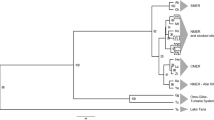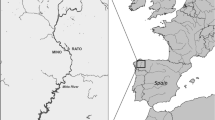Abstract
Genetic variability within and among Bulinus truncatus of the Albertine Rift freshwater bodies were assessed to investigate the degree of inbreeding and gene flow in the snail populations. The effect of ploidy on the genetic structuring of B. truncatus is also described. We characterized the genetic structure of seven B. truncatus populations from Lake Albert, Lake Kivu, and Katosho swamp in Tanzania using five polymorphic microsatellite loci. Genetic differentiation was quantified using pairwise FST values and Nei’s standard genetic distances. Different alleles were observed across all loci and genetic diversity was low although it varied greatly across populations; observed heterozygosity was, however, higher than the expected heterozygosity in three of the populations studied. Significant heterozygote deficiencies were observed coupled with significant linkage disequilibria in five populations for all the five loci examined in this study. We found significant genetic differentiation among the seven freshwater bodies; private alleles were observed across all loci indicating restricted or absence of gene flow between populations. Limited snail dispersal and the reproductive biology of B. truncatus are the major forces shaping the genetic variation observed. Low genetic variation within B. truncatus populations exposes them to a high parasite infection risk as predicted in the Red Queen hypothesis.


Similar content being viewed by others
References
Abdel-hamid, A.-H. Z., J. B. Molfetta, V. Fernandez & V. Rodrigues, 1999. Genetic variation between susceptible and non-susceptible snails to Schistosoma infection using random amplified polymorphic DNA analysis (RAPDS). Journal of Tropical Medicine of Sao Paulo 41(5): 291–295.
Anderson, F. E., 2007. Population genetics of the carinate pillsnail, Euchemotrema hubrichti: genetic structure on a small spatial scale. Conservation Genetics 8: 965–975.
Boelee, E. & H. Laamrani, 2004. Environmental control of schistosomiasis through community participation in a Moroccan Oasis. Tropical Medicine and International Health 9: 997–1004.
Brown, D. S., 1980. Freshwater snails of Africa and their medical importance. Taylor and Francis, London.
Brown, D. S., 1994. Freshwater Snails of Africa and Their Medical Importance, 2nd ed. Taylor & Francis, London.
Burch, J. B., 1960. Chromosome numbers of schistosome vector snails. Parasitology 11: 449–452.
Burch, J. B., 1967a. Chromosomes of intermediate hosts of human bilharziasis. International Journal of Malacology 5: 127–135.
Burch, J. B., 1967b. Some species of the genus Bulinus in Ethiopia, possible intermediate hosts of schistosomiasis haematobia. Ethiopian Medical Journal 5: 245–257.
Campbell, G., L. R. Noble, D. Rollinson, V. R. Southgate, J. P. Webster & C. S. Jones, 2010. Low genetic diversity in a snail intermediate host (Biomphalaria pfeifferi Krass, 1848) and schistosomiasis transmission in the Senegal River Basin. Molecular Ecology 19: 241–256.
Chitsulo, L., D. Engels, A. Montresor & L. Savioli, 2000. The global status of schistosomiasis and its control. Acta Tropica 77: 41–51.
Dundee, D. S., P. H. Phillips & J. D. Newsom, 1967. Snails on migratory birds. The Nautilus 80: 89–91.
Gittenberger, E., D. S. J. Groenenberg, B. Kokshoorn & R. C. Preece, 2006. Molecular trails from hitchhiking snails. Nature 439: 409.
Goldman, M. A., P. T. LoVerde & C. L. Chrisman, 1980. Comparative karyology of the freshwater snails Bulinus tropicus and B. natalensis. Canadian Journal of Genetics and Cytology 22: 361–367.
Goldman, M. A., P. T. LoVerde & C. L. Chrisman, 1983. Hybrid origin of polyploidy in freshwater snails of the genus Bulinus (Mollusca: Planorbidae. Evolution 37: 592–600.
Gow, J. L., L. R. Noble, D. Rollinson & C. S. Jones, 2001. Polymorphic microsatellites in the African freshwater snail, Bulinus forskalii (Gastropoda, Pulmonata). Molecular Ecology Notes 1: 237–240.
Guo, S. W. & E. A. Thompson, 1992. Performing the exact test of Hardy-Weinberg proportion for multiple alleles. Biometrics 48: 361–372.
Hamilton, W. D., R. Axelrod & R. Tanese, 1990. Sexual reproduction as an adaptation to resist parasites (a review). Proceedings of Natural Academy and Science (U.S.A) 87: 3566–3573.
Jarne, P., 1995. Mating system, bottlenecks and genetic polymorphism in hermaphroditic animals. Genetic Research 65: 193–207.
Jarne, P. & T. Stadler, 1995. Population genetic-structure and mating system evolution in fresh-water pulmonates. Experientia 51: 482–497.
Jarne, P., L. Finot, C. Bellec & B. Delay, 1992. Aphally versus euphally in self-fertile hermaphrodite snails from the species Bulinus truncatus (Pulmonata: Planorbidae). The American Naturalist 139: 424–432.
Jarne, P., F. Viard, B. Delay & G. Cuny, 1994. Variable microsatellites in the highly selfing snail Bulinus truncatus (Basommatophora: Planorbidae). Molecular Ecology 3: 527–528.
Jørgensen, A., L. V. G. Jørgensen, T. K. Kristensen, H. Madsen & J. R. Stothard, 2007. Molecular phylogenetic investigations of Bulinus (Gastropoda: Planorbidae) in Lake Malawi with comments on the topological incongruence between DNA loci. Zoologica Scripta 36: 577–585.
Kapito-Tembo, A. P., V. Mwapasa, S. R. Meshnick, Y. Samanyika, D. Banda, C. Bowie & S. Radke, 2009. Prevalence distribution and risk factors for Schistosoma haematobium infection among school children in Blantyre, Malawi. PloS Neglected Tropical Diseases 3(1): e361.
Laamrani, H., J. Mahjour, H. Madsen, K. Khallaayoune & B. Gryseels, 2000. Schistosoma haematobium in Morocco: moving from control to elimination. Parasitology Today 16: 257–260.
Ladle, R. J., 1992. Parasites and sex: catching the Red Queen. Trends in Ecology and Evolution 7: 405–408.
Lively, C. M., 1987. Evidence from a New Zealand snail for the maintenance of sex by parasitism. Nature (London) 328: 519–521.
Lo, C. T., 1972. Compatibility and host-parasite relationships between species of the genus Bulinus (Basommatophora: Planorbidae) and an Egyptian strain of Schistosoma haematobium (Trematoda: Digenea). International Journal of Malacology 11: 225–280.
Mimpfoundi, R. & G. J. Greer, 1990. Allozyme variation among populations of Biomphalaria pfeifferi (Krauss, 1848) (Gastropoda Planorbidae) in Cameroon. Journal of Molluscan Studies 56: 461–467.
Mulvey, M. & R. C. Vrijenhoek, 1982. Population structure in Biomphalaria glabrata: examination of an hypothesis for the patchy distribution of susceptibility to schistosomes. American Journal of Tropical Medicine and Hygiene 31: 1195–1200.
Nalugwa, A., T. K. Kristensen, S. Nyakaana & A. Jorgensen, 2010. Mitochondrial DNA variation in sibling species of the Bulinus truncatus/tropicus complex in Lake Albert, western Uganda. Zoological Studies 49: 515–522.
Nei, M., 1972. Genetic distance between populations. American Naturalist 106: 283–292.
Njiokou, F., C. Bellec, P. Jarne, L. Finot & B. Delay, 1993. Mating system analysis using protein electrophoresis in the self-fertile hermaphrodite species Bulinus truncatus (Gastropoda: Planorbidae). Journal of Molluscan Studies 59: 125–133.
Page, R. D. M., 2001. TreeView32 v. 1.6.6. Distributed by the author [available on internet at http://taxonomy.zoology.gla.ac.uk/rod/rod.html].
Patterson, C. M. & J. B. Burch, 1978. Chromosomes of pulmonate molluscs. Systematics, Evolution and Ecology 2A: 171–217.
Rees, W. J., 1965. The aerial dispersal of Mollusca. Proceedings of the Malacological Society of London 36: 269–282.
Rice, W. R., 1989. Analyzing tables of statistical tests. Evolution 43: 223–225.
Rousset, F., 2008. Genepop: a complete reimplementation of the GENEPOP software for Windows and Linux. Molecular Ecology Resources 8: 103–106.
Satayathum, S. A., E. M. Muchiri, J. H. Ouma, C. C. Whalen & C. H. King, 2006. Factors affecting infection or reinfection with Schistosoma haematobium in coastal Kenya: survival analysis during a nine-year, school-based treatment program. American Journal of Tropical Medicine and Hygiene 75: 83–92.
Sène, M., V. R. Southgate, A. D. De Clercq, A. Ly & J. Vercruysse, 2002. Implication of Bulinus truncatus in the transmission of urinary schistosomiasis in Senegal, West Africa. Annals of Tropical Medicine and Parasitology 96: 175–180.
Stothard, J. R., P. Brémond, L. Andriamaro, B. Sellin, E. Sellin & D. Rollinson, 2001. Bulinus species on Madagascar: molecular evolution, genetic markers and compatibility with Schistosoma haematobium. Parasitology 123: 261–275.
Trouve, S., L. Degen, F. Renaud & J. Goudet, 2003. Evolutionary implications of a high selfing rate in the freshwater snail Lymnea truncatula. Evolution 57: 2303–2314.
Viard, F., P. Bremond, R. Labbo, F. Justy, B. Delay & P. Jarne, 1996. Microsatellites and the genetics of highly selfing populations in the freshwater snail Bulinus truncatus. Genetics 142: 1237–1247.
Viard, F., F. Justy & P. Jarne, 1997. The influence of self-fertilization and population dynamics on the genetic structure of subdivided populations: a case study using microsatellite markers in the freshwater snail Bulinus truncatus. Evolution 51: 1518–1528.
Yeh, F. C., R. C. Yang, J. Mao, Z. Ye & T. J. B. Boyle, 1999. PopGene Version 1.31. Microsoft Window-Based Freeware for Population Genetic Analysis. University of Alberta, Edmonton.
Zakhary, K., 1997. Factors affecting the prevalence of schistosomiasis in the Velta region of Ghana. McGill Journal of Medicine 3: 93–101.
Acknowledgments
We would like to thank the following departments for approval to collect snail samples: the National Centre for Research and Natural Sciences (C.R.S.N) for the permit to sample snails from Lake Kivu at Bukavu, the Tanzania Commission for Science and Technology (COSTECH) to sample at Lake Tanganyika, Kigoma and the National Council for Science and Technology, Uganda. This work was funded by the Danida through Mandahl-Barth Research Centre for Biodiversity and Health at Section for Parasitology, Health and Development, Faculty of life Sciences, University of Copenhagen, Denmark. Part of the field work at Lake Albert was supplemented by the EU-Schistosomiasis Control and Transmission grant (EU-CONTRAST: FP6 STREP contract no: 032203, http://www.eu.contrast.eu).
Author information
Authors and Affiliations
Corresponding author
Additional information
Handling editor: Koen Martens
Rights and permissions
About this article
Cite this article
Nalugwa, A., Jørgensen, A., Nyakaana, S. et al. Genetic variation within and between populations of hermaphroditic Bulinus truncatus tetraploid freshwater snails of the Albertine Rift, East Africa. Hydrobiologia 673, 53–61 (2011). https://doi.org/10.1007/s10750-011-0749-6
Received:
Revised:
Accepted:
Published:
Issue Date:
DOI: https://doi.org/10.1007/s10750-011-0749-6




